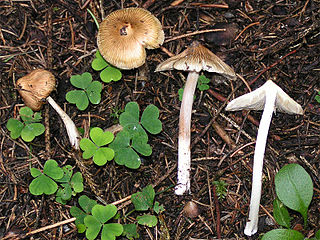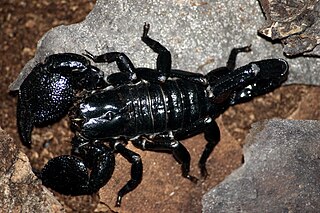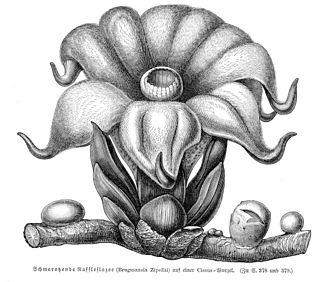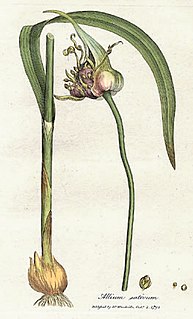
Rhododendron is a very large genus of 1,024 species of woody plants in the heath family (Ericaceae), either evergreen or deciduous, and found mainly in Asia, although it is also widespread throughout lowland and montane forests in the Pacific Northwest, California, the Northeastern United States, and especially in the highlands of the Appalachian Mountains of North America. It is the national flower of Nepal, the state flower of Washington and West Virginia in the United States, the provincial flower of Jiangxi in China and the state tree of Sikkim and Uttarakhand in India. Most species have brightly colored flowers which bloom from late winter through to early summer.

Rubus is a large and diverse genus of flowering plants in the rose family, Rosaceae, subfamily Rosoideae, with over 1,350 species.

Plasmodium is a genus of unicellular eukaryotes that are obligate parasites of vertebrates and insects. The life cycles of Plasmodium species involve development in a blood-feeding insect host which then injects parasites into a vertebrate host during a blood meal. Parasites grow within a vertebrate body tissue before entering the bloodstream to infect red blood cells. The ensuing destruction of host red blood cells can result in disease, called malaria. During this infection, some parasites are picked up by a blood-feeding insect, continuing the life cycle.

Arctostaphylos is a genus of plants comprising the manzanitas and bearberries. They are shrubs or small trees.

Oligochaeta is a subclass of animals in the phylum Annelida, which is made up of many types of aquatic and terrestrial worms, including all of the various earthworms. Specifically, oligochaetes comprise the terrestrial megadrile earthworms, and freshwater or semiterrestrial microdrile forms, including the tubificids, pot worms and ice worms (Enchytraeidae), blackworms (Lumbriculidae) and several interstitial marine worms.

Lumbriculus variegatus, also known as the blackworm or California blackworm, is a species of worm inhabiting North America and Europe. It lives in shallow-water marshes, ponds, and swamps, feeding on microorganisms and organic material. The maximum length of a specimen is 10 cm. Worms raised in laboratory environment are slightly shorter, with 4 to 6 cm long bodies. An adult individual has approximately 150 to 250 1.5 mm wide segments, each of which has the ability to regenerate into a new individual when separated from the rest of the animal. In most populations, this is the primary mode of reproduction, and mature individuals are exceedingly rare; in large areas mature individuals have never been found.

Inocybe is a large genus of mushroom-forming fungi with over 1400 species, including all forms and variations. Members of Inocybe are mycorrhizal, and some evidence shows that the high degree of speciation in the genus is due to adaptation to different trees and perhaps even local environments.

The genus Megachile is a cosmopolitan group of solitary bees, often called leafcutter bees or leafcutting bees; it also includes the called resin bees and mortar bees. While other genera within the family Megachilidae may chew leaves or petals into fragments to build their nests, certain species within Megachile neatly cut pieces of leaves or petals, hence their common name. This is one of the largest genera of bees, with more than 1500 species in over 50 subgenera. The introduced alfalfa leafcutter bee is managed for crop pollination in various regions around the world.
Rhynchelmis orientalis is a freshwater worm.
Yamaguchia toyensis is one of many aquatic oligochaetes belonging to the family Lumbriculidae discovered on the island of Hokkaidō, Japan, which seems to be one of three "hotspots" of lumbriculid diversity. The genus named after the great oligochaete taxonomist Professor Hideji Yamaguchi.

Xestia is a genus of noctuid moths. They are the type genus of the tribe Xestiini in subfamily Noctuinae, though some authors merge this tribe with the Noctuini. Species in this genus are commonly known as "clays", "darts" or "rustics", but such names are commonplace among Noctuidae. Xestia moths have a wide distribution, though they most prominently occur in the Holarctic.

Pangasius is a genus of medium-large to very large shark catfishes native to fresh water in South and Southeast Asia. The term "pangasius" is sometimes used to specifically refer to the commercially important basa fish, P. bocourti.

Culicoides is a genus of biting midges in the family Ceratopogonidae. There are over 1000 species in the genus, which is divided into many subgenera. Several species are known to be vectors of various diseases and parasites which can affect animals. Like Leptoconops, the genus has a long fossil record, with earliest known fossils being from Burmese amber, around 99 million years old.

Verticordia is a genus of more than 100 species of plants commonly known as featherflowers, in the myrtle family, Myrtaceae. They range in form from very small shrubs such as V. verticordina to trees like V. cunninghamii, some spindly, others dense and bushy, but the majority are woody shrubs up to 2.0 m (7 ft) tall. The flowers are variously described as "feathery", "woolly" or "hairy" and are found in most colours except blue. They often appear to be in rounded groups or spikes but in fact are always single, each flower borne on a separate stalk in a leaf axil. Each flower has five sepals and five petals all of a similar size with the sepals often having feathery or hairy lobes. There are usually ten stamens alternating with variously shaped staminodes. The style is simple, usually not extending beyond the petals and often has hairs near the tip. All but two species are found in Southwest Australia, the other two occurring in the Northern Territory.

Bembidion is the largest genus of beetles in the family Carabidae by number of species. All species are small and move very fast. Most of them live close to water. The genus has a biantitropical distribution, meaning they are found in both the Northern and Southern Hemispheres, but not in the tropics. In warmer regions it is substituted by closely related Tachys and other genera.

Pandinus is a genus of large scorpions belonging to the family Scorpionidae. It contains one of the most popular pet scorpions, the emperor scorpion . The genus is distributed widely across tropical Africa and the southeastern Arabian Peninsula.

Rhizanthes is a genus of four species of parasitic flowering plants in the family Rafflesiaceae. They are without leaves, stems, roots, or photosynthetic tissue, and grow within the roots of a few species of Tetrastigma vines. The genus is limited to the tropical forests of Southeast Asia. The flowers of Rhizanthes are very large, they vary from 14 to 43 cm in diameter. At least one species of Rhizanthes, Rh. lowii, is endothermic.

Allium is a genus of monocotyledonous flowering plants that includes hundreds of species, including the cultivated onion, garlic, scallion, shallot, leek, and chives. The generic name Allium is the Latin word for garlic, and the type species for the genus is Allium sativum which means "cultivated garlic".
Limnodrilus is a genus of Naididae.
Eclipidrilus is a genus of annelids belonging to the family Lumbriculidae.















